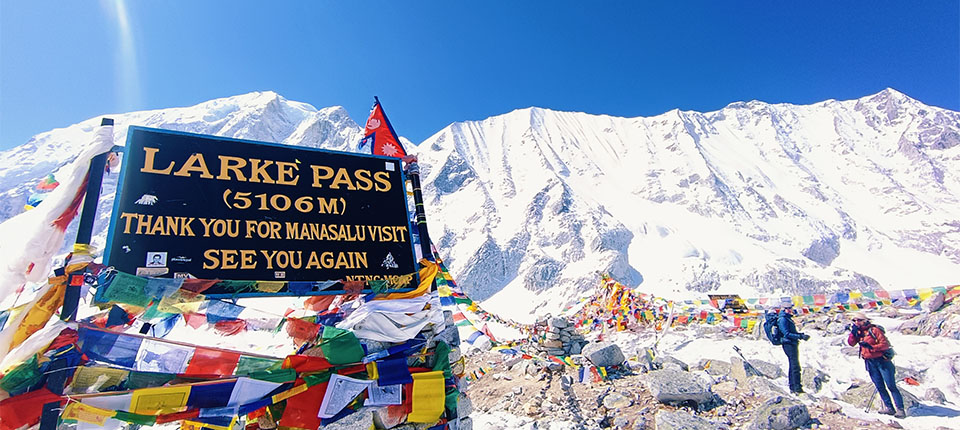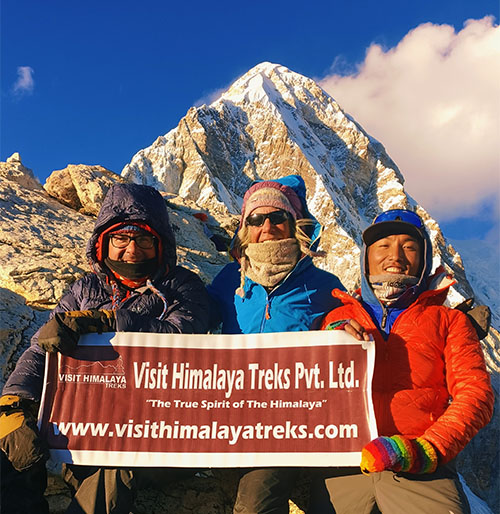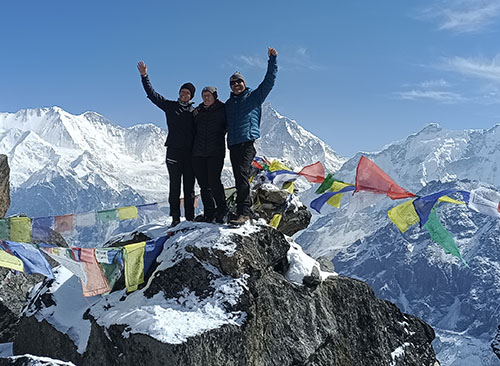The Manaslu Larke Pass Trek is one of Nepal's most rewarding and scenic off-the-beaten-path hikes. Also referred to as the Manaslu Circuit Trek, this amazing trekking experience treats you to a diverse landscape, ranging from subtropical jungles and deep river gorges to high-alpine meadows and snow-capped peak passes.
The trek passes through remote Himalayan villages, ancient monasteries, and ethnically Tibetan-influenced towns, and finally to the breathtaking Larke La Pass (5,160 meters). In this blog, there is detailed information about the overall distance of the trek, major portions, and what lies ahead at each major phase, allowing you to plan a memorable and well-arranged Himalayan adventure with Visit Himalaya Treks.
1. Introduction: Why Distance Matters in the Manaslu Circuit Trek via Larke La Pass.
When organizing a high-altitude trek in Nepal, being aware of the daily distance is as important as acclimatization for the elevation. The Manaslu Larke Pass Trek measures about 177 kilometers (110 miles) in 16 to 20 days based on your schedule, pace, and acclimatization needs. Although not the most strenuous trek in Nepal, the physicality of the trail, the elevation, and the isolated trail make it one of the more challenging and rewarding Himalayan treks.
As compared to the heavily trafficked routes as Annapurna or Everest, the Manaslu Circuit is relatively less visited and more authentic, giving trekkers an authentic opportunity to witness unspoiled mountain culture, serene landscapes, and genuine hospitality. The gentle increase in altitude allows for a natural and safe process of acclimatization, and the diverse range of distances between village and village creates a rhythm that is both challenging and highly interactive. Whether you are an established trekker or an active traveler who wants an alternative trekking route, the distance and terrain of the trek represent the first step in making the most out of the experience.
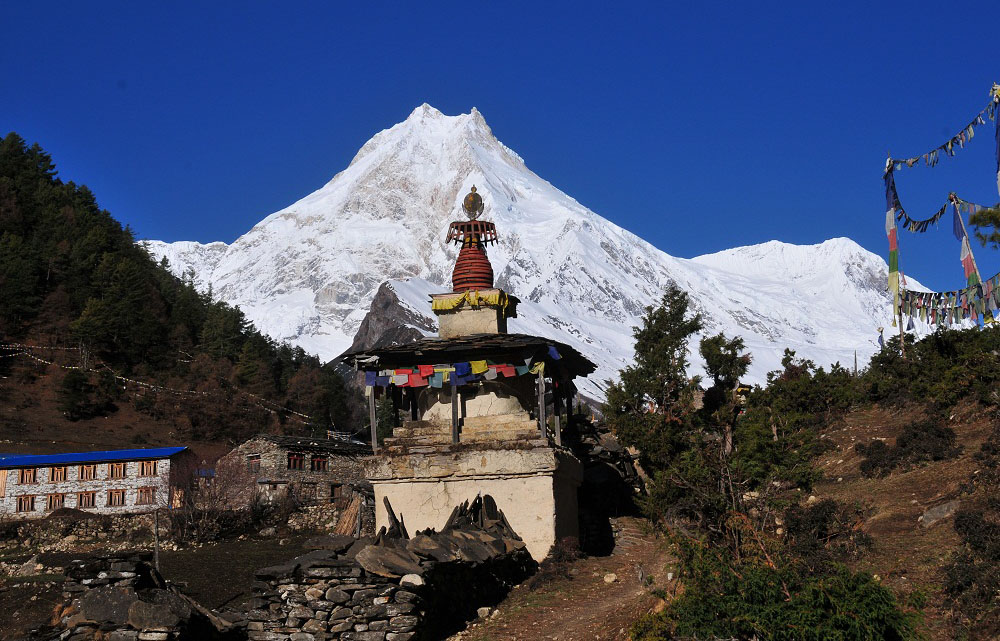
View of the Old Traditional Buddhist Stupa with Mount Manaslu in the Background.
2. Overview of Manaslu Circuit Trek via Larke Pass Trek Distance.
- Total Trekking Distance: Approx. 177 km / 110 miles
- Start Point: Barpak / Soti Khola or Machhakhola.
- End Point: Dharapani.
- Highest Point of the Trek: Larke La Pass, 5,160 meters (16,929 ft).
- Average Daily Distance: 10–15 km.
- Total Duration: 14–16 days (including acclimatization)
3. Highlights of Manaslu Circuit Trek via Larke La Pass Route.
- Trekking through the beautiful Budhi Gandaki River gorge.
- Hike through beautiful forests, remote Tibetan villages, and suspension bridges.
- Explore Sama Gaon and Samdo: two culturally significant Himalayan villages.
- Cross the snow-laden Larke La Pass (5,160 m) with panoramic mountain views.
- Enter the Annapurna region through descent, completing a full circuit.
- Explore medieval monasteries such as Pungyen Gompa and Serang Gompa.
- Enjoy panoramic views of Mt. Manaslu (8,163 m), the world's eighth-highest peak.
- Experience traditional mountain life and Tibetan culture in the Nubri Valley.
- Hike via varied landscapes from subtropical jungles to alpine meadows.
- Spot Himalayan wildlife like blue sheep, Himalayan tahr, and lammergeier vultures.
- Stay in teahouses with welcoming hospitality in unspoiled mountain villages.
- Meet fewer people than on the Annapurna and Everest routes.
- See the contrast between stark high-altitude landscapes and lush lowland valleys.
- Cross thrilling suspension bridges over thundering glacial streams.
- Enjoy peaceful, off-the-beaten-path hiking ideal for trekkers.
4. Day-by-Day Trekking Distance Breakdown for Manaslu Circuit Trek via Larke La.
Day 1: Drive to Soti Khola or Barpak.
- No trekking distance (drive by road from Kathmandu 142 km to Sotikhola and 176 km to Barpak.
Day 2: Barpak to Laprak.
- Approx. 16 kilometers.
- Follows the wonderful hillside walk involving uphill and downhill.
Day 3: Laprak to Khorla Besi.
- Approx. 16 kilometers.
- Involves a step downhill and uphill.
Day 4: Khorla Besi to Phillim.
- Approx. 22 kilometers.
- Crosses narrow gorges and offers beautiful rural views.
Day 5: Philim to Bihi Phedi.
- Approx. 18 kilometers
- A gradual ascent through pine forests and into a culturally Tibetan country.
Day 6: Bihi Phedi to Serang Gompa.
- Approx. 10 kilometers.
- Step uphill and forest walking are involved.
Day 7: Serang Gompa to Gap.
- Approx. 18 kilometers.
- Step uphill, forest walk, and downhill are involved.
Day 8: Gap to Lho.
- Approx. 16 kilometers.
- Less difficult climb day, with the first good glimpse of Manaslu.
Day 9: Lho to Sama Gaon.
- Approx. 12 kilometers.
- Easy walking with numerous opportunities to enjoy the view or a long day hike to Pungyen Gompa.
Day 10: Acclimatization Day at Sama Gaon.
- No fixed distance.
- Side excursion to Manaslu Base Camp, Birendra Tal.
Day 11: Sama Gaon to Samdo.
- Approx. 8 kilometers.
- Gradual ascent over yak grazing grounds and alpine meadows.
Day 12: Samdo to a Side trip Tibet border.
- Approx. 16-18 kilometers.
- Long hike along towards to Tibet border and back to Samdo.
Day 13: Samdo to Dharamsala (Larke Phedi)
- Approx. 7 kilometers
- Gentle but sustained ascent, warming up to cross the high pass.
Day 14: Cross Larke La Pass to Bimthang.
- Approx. 24 kilometers (the longest and most difficult day)
- Crosses Larke La Pass (5,160m) with stunning Himalaya views.
Day 15: Bimthang to Tilje or Dharapani.
- Approx. 17–20 kilometers
- Long downhill trek through alpine woods and village communities.
Day 16: Drive from Dharapani to Kathmandu via Besisahar.
- No trekking distance.
- Scenic drive along mountain roads, descending through lush hills and riverside settlements into the lower Annapurna region.
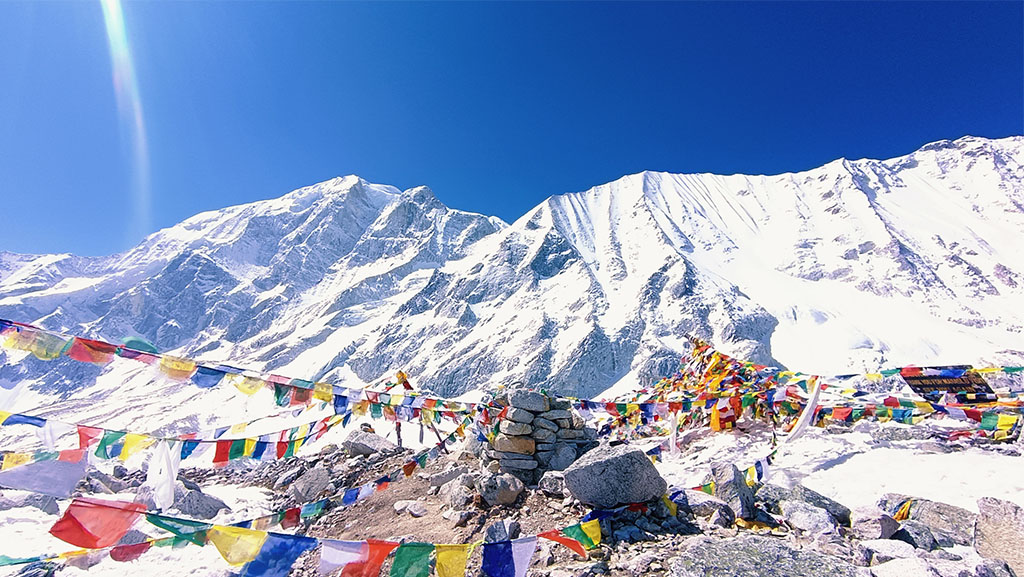
Larke La Pass, with an elevation of 5,106 meters.
5. How Difficult Is the Trek Based on Distance?
Despite the daily distances on Manaslu Larke Pass Trek appearing reasonable, 10–15 kilometers a day on average, the real challenge is in the altitude gain, the remote scenery, and Larke La Pass altitude (5,160 meters). There are 5 to 7 hours of steady walking most days along varied scenery, from the lowland jungle humidity to wind-blasted alpine zones.
Day 14 is the most physically demanding day, with trekkers crossing the Larke La Pass. It alone is almost 24 kilometers long and takes 10 to 11 hours, with a steep, early morning ascent and an extremely lengthy descent all the way down to Bimthang. The effects of high altitude, thinner air, and inclement weather can significantly contribute to how hard the trek is on this day.
Despite these challenges, Manaslu Circuit is graded a moderately challenging trek and is very much within the reach of fit newcomers and intermediate trekkers, as long as professionals lead them. Himalaya Treks designs the itinerary with acclimatization days incorporated in strategic locations like Sama Gaon and Samdo. This gradual ascent approach, coupled with trained guides and porter support, ensures your trek is safe, well-timed, and very rewarding, no matter what your previous experience on a trek.
6. Tips for Efficient Trek Distance Management for Manaslu Circuit Trek via Larke Pass.
Start Slow and Gradually Increase Speed.
In the initial couple of days of the Manaslu Larke Pass Trek, one should maintain a slow and steady rhythm. Trekkers will try to push themselves too hard in the early days, but the trek gradually increases in altitude and difficulty. Allowing your body to adjust to the terrain and altitude for the first couple of days reduces the exhaustion, and the experience overall is more pleasant.
Drink Often, Especially Higher Up.
When you ascend above 3,000 meters, the air is less dense and water evaporates more rapidly from your body. Hydration is also among the best ways to prevent altitude sickness (AMS). Have 3–4 liters of water daily, and avoid alcohol or caffeine, as these dehydrate.
Use Trekking Poles for Support.
Trekking poles aren't only for mountainous terrain; they take some of the weight off, provide better balance, and ease the stress on your knees, particularly when descending steep inclines like the one at Larke La Pass. They're also great for staying in rhythm and saving energy for long distances.
Hire a Porter to Carry Your Load.
With a porter, you can trek comfortably with just a light daypack, significantly reducing fatigue and optimizing endurance. Himalaya Treks has reliable porter services available to provide, simplifying trekking and giving you room to focus on the experience and not the luggage.
Train Before Your Trek.
It is essential to prepare your body beforehand to be able to handle the distance and elevation of the Manaslu Circuit. Start cardio exercises such as running, cycling, or hiking weeks prior to your trip. Incorporate walking uphill with a backpack to mimic the conditions of trekking and to strengthen and condition your legs.
FAQs regarding Manaslu Larke Pass Trek Distance.
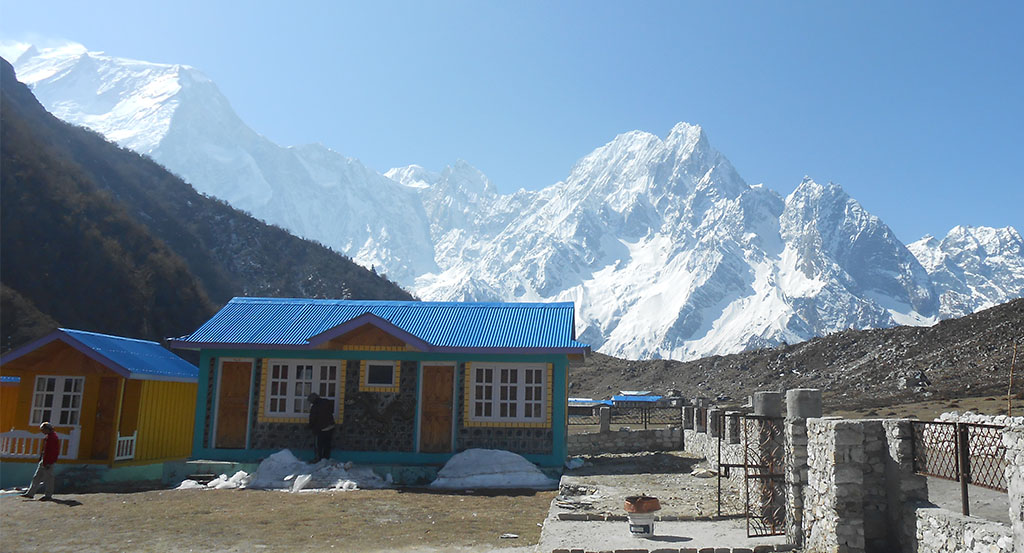
A local tea house located in Bhimtang, which is along the route to the Manaslu Circuit Trek.
1. What is the distance of the Manaslu Larke Pass Trek?
The Manaslu Larke Pass Trek is roughly 177 kilometers (110 miles) from beginning to end. The overall distance can be somewhat different based on where you commence (Barpak or Soti Khola) and whether you include day trips to places such as Manaslu Base Camp or Serang Gompa.
2. How many days do you need to complete the trek?
Typically, it takes 14 to 20 days, including acclimatization days and travel to/from the trailhead. Visit Himalaya Treks offers a nicely paced 20-day itinerary to have good altitude adaptation and cultural experiences.
3. What is the longest trekking day on the Manaslu Circuit Trek via Larke Pass?
The longest and toughest day is the Larke La Pass crossing, where trekkers hike approximately 24 kilometers from Dharamsala (Larke Phedi) to Bimthang, which takes 8–10 hours depending on weather and physical conditions.
4. Is the distance ideal for beginners?
Although the distance and altitude make this trek moderate to highly strenuous, first-time trekkers who are physically fit can complete it with proper preparation, acclimatization, and the help of a qualified guide.
5. What is the daily distance traveled?
Most days involve 8 to 15 kilometers of walking, with an average 6–7 hours of hiking. The trek is well planned to enable trekkers to acclimatize gradually to the increasing altitude.
6. Can the trekking distance be shortened?
Yes. Side trips can be avoided, and transport can be arranged to cut the itinerary short. Some trekkers prefer jeep access halfway or miss the Barpak–Laprak section. Consult with Visit Himalaya Treks to tailor the experience.
7. Is the distance inclusive of acclimatization days?
Yes, the total days incorporate acclimatization stops, specifically in Sama Gaon and Samdo. The rest days are important for high-altitude acclimatization, even though they do not cover great distances.
8. What is the altitude gain over the distance?
You begin from around 900 meters (Soti Khola) and ascend gradually to 5,160 meters at Larke La Pass, which is a considerable but gradual altitude gain over the course of the trek.
9. What kind of terrain does the distance cross?
The distance covers an enormous variety of landscapes, from subtropical forests and river gorges to alpine meadows and high glacier country at altitude, which makes the distance more dynamic and spectacular in feel.
10. How do I train to cover this distance?
Train by performing cardio (running, cycling, hiking), including stair climbing and walking uphill, and train while carrying a backpack. Hydration, acclimatization, and walking with a guide from Visit Himalaya Treks will enable you to cover the total distance safely and comfortably.

